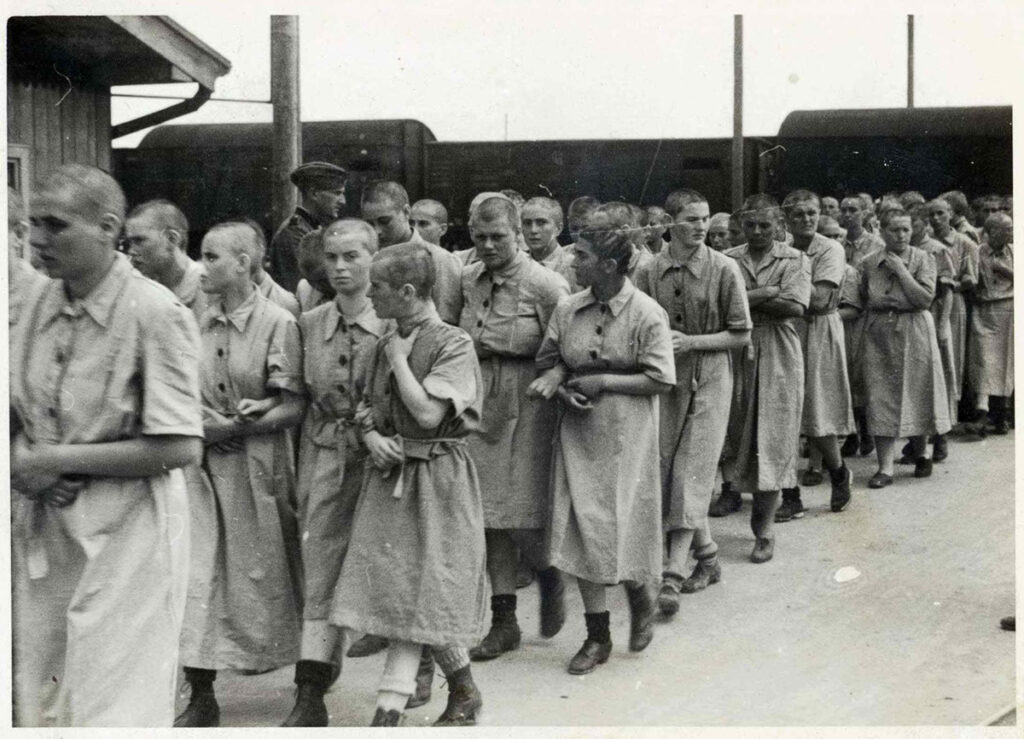Introduction – Women in Auschwitz
Between 1942 and 1944, around 400,000 women were deported to Auschwitz. Only a fraction survived. Their stories reveal both the specific brutality they endured and the strength of solidarity that often helped them resist despair. The history of victims and survivors of Auschwitz is incomplete without acknowledging the particular suffering of women.
Deportations and Arrival
Women arrived in Auschwitz mostly as part of family transports. After the exhausting train journeys, they faced selections on the ramp at Birkenau. Mothers with young children or women accompanying the elderly were usually sent directly to the gas chambers. Those registered as prisoners were stripped of their belongings, shaved, and assigned numbers. For many, this was the start of dehumanisation.

Shaving of Heads
The shaving of heads was a traumatic ritual imposed on all new arrivals. Although justified by the SS as a “hygienic measure,” it was above all an act of humiliation. For women, hair symbolised femininity, identity, and sometimes religious tradition. To lose it meant the loss of dignity. Even worse, women learned that their hair was collected, stored in sacks, and sent to factories in the Reich for industrial use. Survivors recalled that this moment left a deeper psychological scar than receiving a tattooed number.
Living Conditions for Women
The women’s camp in Birkenau (Frauenlager) was overcrowded, filthy, and plagued by epidemics such as typhus. Prisoners were crammed into wooden bunks, often without blankets. Daily rations amounted to slow starvation. Yet even in such conditions, women often formed networks of solidarity – sharing food, helping the sick, or offering comfort. Some of the youngest suffered alongside their mothers, as described in our article on Children in Auschwitz.
Motherhood and Children
Motherhood in Auschwitz meant unbearable choices. Women with children were usually murdered on arrival. Pregnant women were killed or subjected to experiments. Still, testimonies speak of mothers risking everything to hide or protect their children, or breastfeeding newborns despite knowing their survival was unlikely. Their stories remain among the most tragic aspects of women’s experiences in the camp.
Forced Labour and Daily Life
Those selected for work were assigned to women’s labour kommandos. They dug ditches, carried bricks, or toiled in nearby factories such as IG Farben. Others worked in the so-called Canada warehouses, sorting belongings taken from murdered deportees. The work was exhausting and often deliberately humiliating, designed to break prisoners physically and psychologically.
Medical Experiments on Women
Auschwitz was also the site of horrific medical experiments, especially on women. In Block 10, doctors such as Carl Clauberg and Horst Schumann conducted sterilisation and gynaecological experiments without anaesthesia, leaving many women permanently injured or dead. Josef Mengele carried out experiments on twins and pregnant women, targeting female prisoners in particular. These atrocities underline why remembering the victims and survivors of Auschwitz is inseparable from documenting the gendered nature of Nazi crimes.
Female SS Guards and Overseers
Women in Auschwitz were not only victims. Female SS guards, known as Aufseherinnen, supervised labour details and prisoner blocks. Maria Mandel, head of the women’s camp, became infamous for her role in selections and brutality. The Auschwitz Memorial’s material on women supervisors documents how female perpetrators contributed to the machinery of destruction. Their presence challenges stereotypes about gender and violence during the Holocaust.
Survivors’ Testimonies and Legacy
Despite unimaginable conditions, many women bore witness after the war. Some describe friendships that gave them strength, others recall singing or writing secretly as acts of defiance. According to the USHMM overview on women during the Holocaust, female prisoners faced unique abuses but also displayed remarkable resilience. For more personal accounts, the Yad Vashem podcast on women in Auschwitz gives voice to survivors themselves. Their testimonies are central to understanding Auschwitz not only as a place of death but also as a site of human endurance.
Conclusion – Remembering the Women of Auschwitz
The experience of women in Auschwitz reflects both unimaginable suffering and profound courage. They endured hunger, forced labour, medical experiments, and the loss of children, yet they also showed resilience and solidarity. As the Auschwitz Memorial’s podcast on women at Auschwitz reminds us, their voices are essential for preserving the truth of the Holocaust. Remembering the women of Auschwitz ensures that their stories remain a vital part of history.
